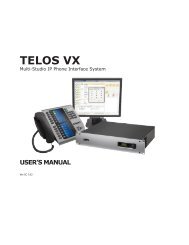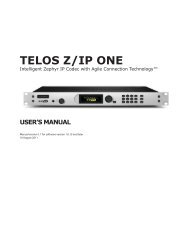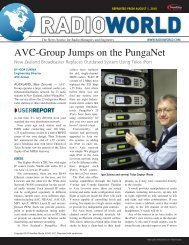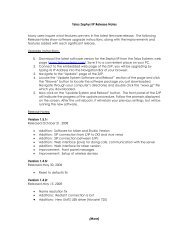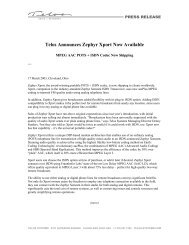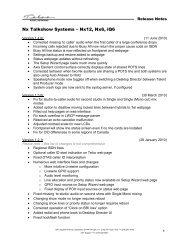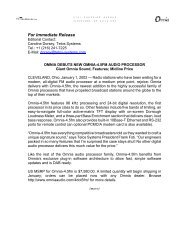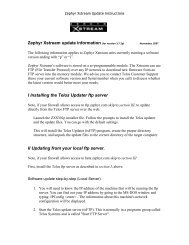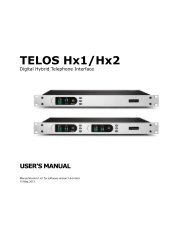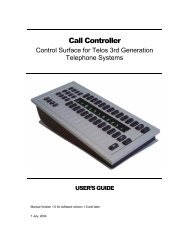NOW! 12-13 - Telos
NOW! 12-13 - Telos
NOW! 12-13 - Telos
Create successful ePaper yourself
Turn your PDF publications into a flip-book with our unique Google optimized e-Paper software.
AXIA | CONSOLES<br />
62<br />
ELEMENT<br />
CAN A RADIO CONSOLE BE OVER-ENGINEERED?<br />
ONLY IF YOU THINK "GOOD ENOUGH" REALLY IS GOOD ENOUGH.<br />
SILVER<br />
BRONZE<br />
Building great consoles is more than punching holes in sheet<br />
metal and stufing a few switches in them. Building a great<br />
console takes time, brain-power and determination. That’s<br />
why we’ve hired brilliant engineers who are certiied “OCD”:<br />
Obsessive Console Designers, driven to create the most useful,<br />
powerful, hardest-working consoles in the world. And that description<br />
certainly its Axia’s modular Element 2.0 mixing console.<br />
Scalable from 2 to 40 faders, Element is the ultra-reliable<br />
dynamo at the center of over 3000 Axia-powered broadcast<br />
studios around the world.<br />
We launched Axia in 2003 to make digital mixing consoles —<br />
but with a twist: Axia consoles would be integrated with the<br />
routing switcher, and networked to share resources and capabilities<br />
throughout the studio complex. This intelligent network<br />
of studio devices gives your talent consoles that are more<br />
powerful and easier to use than ever. Our team of engineers<br />
blended the best ideas from old-school analog consoles with<br />
innovative new technology to produce bullet-proof boards that<br />
can actually make shows run smoother and sound better.<br />
And we invented a way to network studios, consoles and audio<br />
equipment using Ethernet. It’s called Livewire, and it’s now<br />
an industry standard. Livewire carries hundreds of channels<br />
of real-time, uncompressed audio plus synchronized control<br />
logic and program-associated data on just one skinny CAT-6<br />
cable. And, because Axia networks are intelligent Ethernet-<br />
based routing systems, machine logic always follows source<br />
audio. Simply load a source on any fader – in any studio – and<br />
that fader’s controls are immediately communicating with the<br />
source device. Thanks to this scalable network technology, integrated<br />
router control is a standard feature of every Element.<br />
Board-ops told us they wanted a powerful console that’s still<br />
easy to use: user-friendly, but with all the power of a full-on<br />
production board. Element is! Show Proiles can recall each operator’s<br />
favorite settings with the push of a button — audio<br />
sources, fader assignments, monitor settings and more. Each<br />
jock’s Show Proile contains personalized mic processing and<br />
voice EQ settings that load every time they’re on the air (so the<br />
midday guy will stop badgering you for “just a little more low<br />
end”). There’s even a “panic button”: one key-press returns a<br />
Show Proile to its default state instantly.<br />
Powerful? You bet. Element has 4 Program buses plus 4 Aux<br />
sends and 2 Aux returns, and 16 5-channel “virtual mixer” that<br />
lets you mix multiple audio streams using virtual faders. Every<br />
voice channel has studio-grade compression, de-essing and<br />
gating courtesy of the processing experts at Omnia, plus threeband<br />
parametric EQ. There’s even built-in headphone processing<br />
to save the cost of a separate side-chain.<br />
More convenience: fully-automatic mix-minuses; one for each<br />
fader if you need it. Mix-minus settings are saved for each<br />
audio source, so that sources, backfeed and machine logic all



